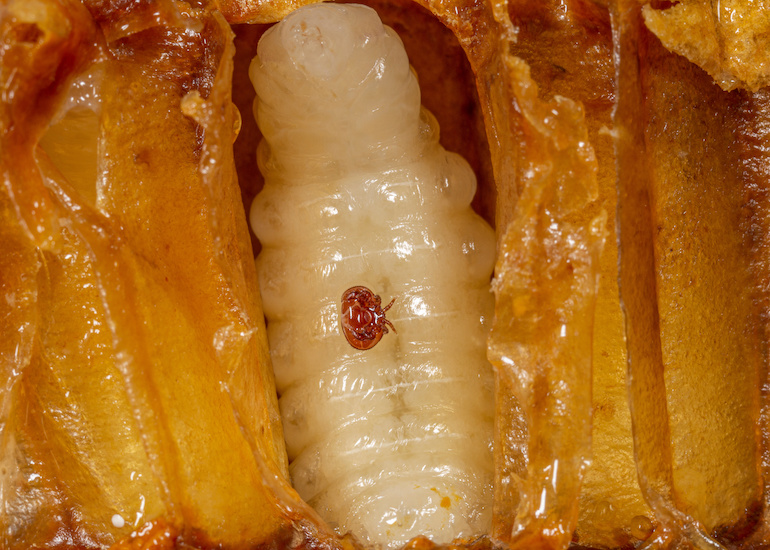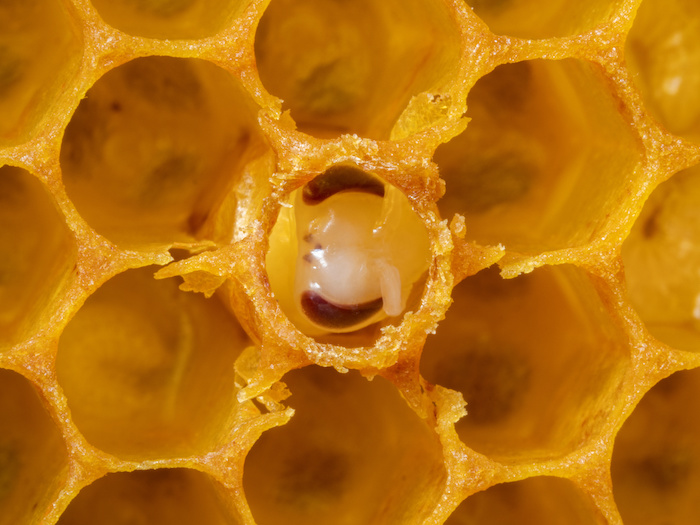 by Véto-pharma
by Véto-pharma Wax hygiene is often an overlooked aspect of hive management. However, it plays a critical role in ensuring the health of honey bees and strengthening efforts to control varroa (Varroa destructor) infestations.1
Over time, pathogens2 and residues from varroa treatments3 can accumulate in beeswax, posing significant risks to colony health and diminishing the effectiveness of these treatments in the future.
So, why and how should you renew your wax combs to protect your bees? Let’s explore this together.
When residues of varroa treatments persist in beeswax, honey bees and varroa mites are exposed to them in the long-term.
This low-level exposure of the local mite population to a specific active ingredient over a prolonged timespan represents one of the main potential pathways to resistance development against varroacides.4
Thus, in helping to prevent pathogen exposure and resistance against specific varroa treatments, the renewal of old wax combs on a regular basis (mostly recommended every three years) is an important tool for honey bee health management and varroa control.5
In addition to the well-recognized potential risks of residue accumulation in wax, additional arguments could be made to support the significance of beekeepers renewing wax combs. Here, we want to present the results of a recently published study by Zhang et al. (2024), “Large cells suppress the reproduction of Varroa destructor” (Pest Management Science), which potentially adds another argument in favor of wax renewal.6
In the search for effective varroa mite (Varroa destructor) control methods, the reproductive phase of adult female varroa mites has received much attention in the past.7-8 The reproductive success of female varroa mites in bees’ brood cells depends on various factors: From nutritional status to the subspecies of the host (bee) to mating conditions inside the brood cell, different hypothesis have been proposed concerning optimal or less-than-optimal conditions for reproductive success in this parasite.6
One of the more frequently investigated factors since the 1990s is the cell size in bee brood comb and its effects on varroa mite fecundity and fertility.6,9 While some studies have found that small brood cell size can impede the reproduction of varroa mites, other research results have contradicted these findings or found no impact of cell size differences.6
In the recently published study by Zhang et al. (2024), the authors investigated the effects of brood cell size on varroa reproductive success in the laboratory. Utilizing different methodologies (gelatin capsules serving as brood cells, measuring gonopore size in adult varroa mites, and working with 3D-printed comb foundation cells of different cell width), this study aimed to detect potential differences in varroa mite fecundity, fertility, and gonopore size, depending on the size (diameter, width) of the brood cell. 6

For this study, early fifth instar worker bee larvae were collected from honey bee colonies with a low varroa mite infestation and transferred to the laboratory for experiments. All varroa mites sampled for this investigation were sourced from highly infested colonies. Two different sizes of gelatin capsules were prepared to serve as brood cells for varroa reproduction:
In three treatment groups and one control group, bee larvae and varroa mites were transferred into the capsules before the gelatine capsules were sealed and incubated at 34.5 °C and 75% Relative Humidity. The treatment groups were:
Additionally, a control group that had one worker larva in a size 1 capsule without varroa present was included, and a relatively high average host larvae survival rate (88.3%) was measured for this group.6
Both, the fertility and the fecundity of female varroa mites were found to be significantly different between groups (1) and (2).
In a second step, the authors measured differences in reproductive outputs of mother mites, which can be predicted by the variation in their gonopore size. They found that female varroa mites which were raised in larger capsules had smaller gonopores (genital pore in invertebrates).6
Interestingly, the outcome changed as soon as an additional (second) larva was added to the larger sized gelatine capsule. Fecundity and fertility were restored in the third treatment group (iii) and showed no significant difference compared with varroa females inoculated in the smaller sized capsule with a single larva.
Furthermore, the gonopore size of mites in bigger cells containing two larvae increased during the initial stages of reproduction and became equivalent to that of mites in the smaller brood cells.6
This indicates that varroa mite fertility may not only be influenced by the absolute size of the brood cell but by the relative size of the host within that cell.
As working with gelatine capsules limits the potential size options for the simulated brood cells and the shape is also different from real bee brood cells, the authors decided to utilize 3D-printed brood comb for further investigations. Comb foundations with different cell widths were generated, and the results matched those of the previous experiment with gelatine capsules.
Although the authors emphasize that the reproduction of varroa mites is a highly complex process with many underlying factors influencing reproductive success, they conclude that larger brood cells impede varroa mite reproduction. This finding is consistent with the results of some earlier studies on the subject that were conducted in the field.
Considering that treatment groups (group 1) and (group 3) both resulted in higher fecundity and fertility of varroa mites, the authors are speculating that the ratio between cell size and host (larva) size might in fact be the main factor influencing reproductive outcomes for varroa mites.6

A possible explanation for these findings could be the greater dispersion or weakening of chemical cues in bigger brood cells. Both drone and worker brood emit volatile substances that affect the varroa mites’ host-finding behavior. If this mechanism was delayed or slightly impaired by the (relatively) bigger cell size, it could pose a disruption or cause delay in the varroa reproductive phase.6
Interpreting these results in the context of varroa control and IPM (Integrated Pest Management) in varroa treatment plans, these findings could point toward an additional benefit of renewing old brood combs in honey bee colonies on a regular basis. Over time, worker bee brood cells become smaller with increasing comb age.10
Known disadvantages associated with smaller worker brood cells in old comb are significant negative effects on:
In addition, the results of the study presented above suggest a potential benefit in the form of lower reproductive success of varroa mites.6
For beekeepers, all of these factors clearly point out that renewing old wax comb on a regular basis provides many advantages for honey bee colony health.
Apis cerana cerana (the Eastern honey bee) is much less vulnerable to the detrimental consequences for honey bee health associated with varroa mite infestation compared with the Western honey bee, Apis mellifera spec.12-13
While many publications have suggested different behavioral adaptations of Apis cerana cerana to varroa mite infestation as well as the presence of a much older, co-evolved host-parasite system between the Eastern honey bee and varroa mites14-15, not many studies have investigated the specific effects of hygiene behaviors on brood cell size.
Peng et al. (2023) provide some answers in this regard.16 Their study demonstrates that Apis cerana cerana gnaws off old brood cells in two different ways:
Workers then build new cell walls on the old cell bases containing a small amount of cocoon to form semi-rebuilt brood cells. The diameter and volume of these semi-rebuilt brood cells are almost the same as of the newly built brood cell but significantly larger than the old brood cell.14
While this behavior in Apis cerana cerana is also associated with some other, above-mentioned advantages such as the resulting morphologically bigger worker bees,14 the significance of observing enlarged brood cells as a resulting from this “gnawing” or “cleaning” behavior in a species that is often described as “varroa tolerant bees”, should be noted.
Follow-up studies to further investigate the relationship between worker bee brood cell size or the ratio between cell size and host size and the respective reproductive success of varroa mites in different honey bee sub-species could prove beneficial in the search for new varroa control methods.
References:
 by Véto-pharma
by Véto-pharma  by Juan Molina
by Juan Molina